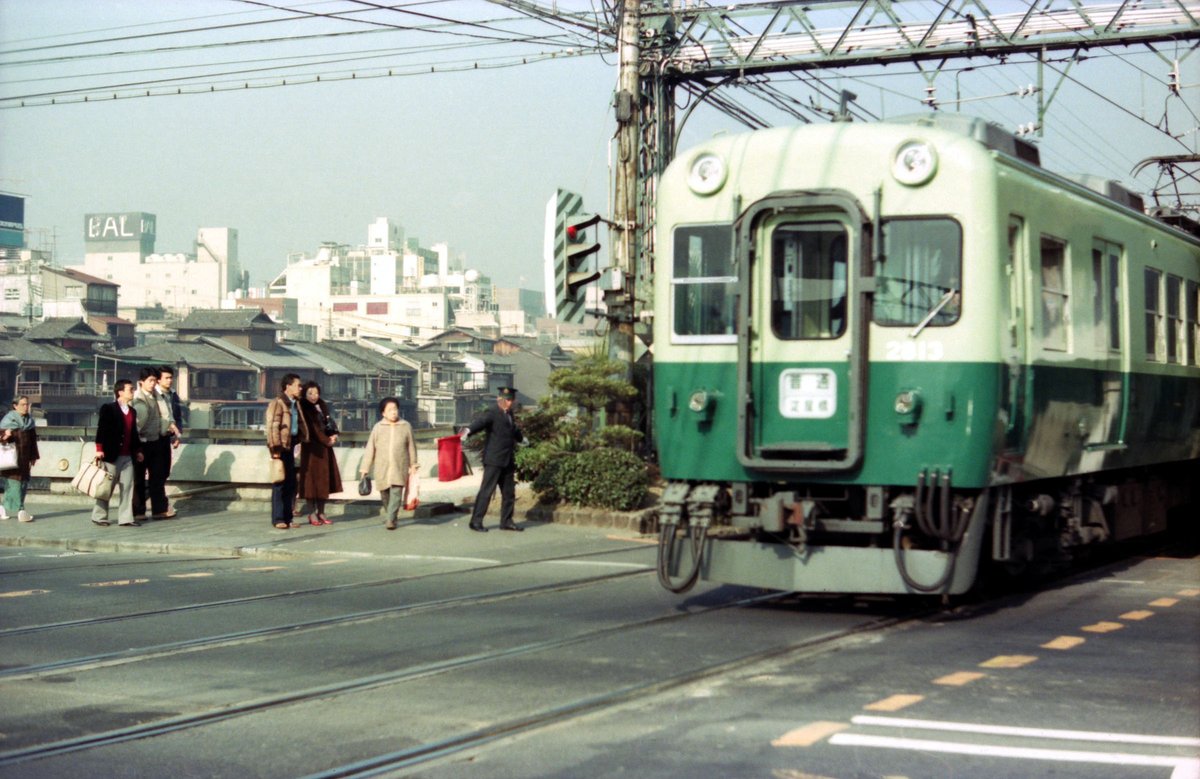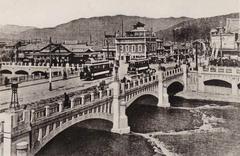
Gion-Shijō Station Kyoto: Visiting Hours, Tickets, and Historical Sites Guide
Date: 14/06/2025
Introduction to Gion-Shijō Station and Its Significance in Kyoto
Gion-Shijō Station stands as a crucial portal to Kyoto’s storied Gion district, seamlessly bridging modern transit with centuries-old tradition. Located on the Keihan Main Line beneath Shijō Street near the Kamo River, this underground station provides barrier-free access to the heart of Kyoto’s historic and cultural landscape. With direct connections to landmarks such as Yasaka Shrine, Hanamikoji Street, and the atmospheric Shirakawa Canal, Gion-Shijō Station allows visitors to explore the living heritage of Kyoto with ease.
The Gion district itself has evolved from a Heian period temple town into a celebrated center of geisha culture and traditional entertainment. Today, its streets are lined with preserved machiya townhouses, teahouses, and venues for seasonal festivals like the renowned Gion Matsuri. This comprehensive guide offers up-to-date information on operating hours, ticketing, accessibility, transportation routes, and the must-see sites that make Gion a captivating destination for travelers from around the world.
For the latest updates and travel resources, consult the Keihan Electric Railway website and Kyoto City Tourism Official Site (Gion-Shijō Station Guide, Magical Trip, Mai-Ko).
Table of Contents
- Introduction
- Historical Background of Gion-Shijō Station
- Visiting Gion-Shijō Station: Practical Information
- Nearby Attractions and Access
- Special Events and Guided Tours
- Preservation and Modernization
- Exploring Gion District: History, Culture, and Visitor Information
- Seasonal Events and Experiences
- Visiting Yasaka Shrine: Hours, Tickets, and Travel Tips
- Transportation Guide
- Visitor FAQs
- Visual Gallery & Related Articles
- Conclusion
- Sources
Historical Background of Gion-Shijō Station
Gion-Shijō Station opened in the early 20th century as Shijō Station, serving as a key node in the growing Keihan Electric Railway network connecting Kyoto and Osaka. In 2008, it was renamed Gion-Shijō Station to clarify its proximity to the Gion district and distinguish it from similarly named stations.
Location and Urban Integration
Strategically located below Shijō Street at the Kamo River’s western bank, the station sits at the intersection of old and new Kyoto. Its underground design preserves the district’s historical streetscape and allows seamless, barrier-free movement between platforms, street level, and nearby attractions.
Visiting Gion-Shijō Station: Practical Information
Operating Hours
- Trains: Daily, approximately 5:30 AM to midnight.
- Facilities: Ticket counters and shops may have varied hours. Check in advance, especially during holidays and festivals.
Ticketing
- Purchase tickets at station machines or counters.
- IC cards such as ICOCA and PiTaPa are accepted.
- Day passes and discounted tickets are available for tourists.
Accessibility
- Elevators, escalators, and tactile paving are provided.
- Staff assistance is available during most hours.
- The station is designed for smooth, barrier-free navigation.
Travel Tips
- Arrive early or late to avoid peak crowds, especially during Gion Matsuri (July).
- Kawaramachi Station (Hankyu Kyoto Line) is nearby for additional transit options.
- Begin guided tours from the station for expert-led exploration.
Nearby Attractions and Access
- Yasaka Shrine: 5-minute walk east; spiritual and festival center.
- Hanamikoji Street: 7 minutes southwest; iconic for preserved teahouses.
- Shirakawa Canal: 10 minutes northeast; picturesque, willow-lined.
- Kenninji Temple: 10 minutes south; Zen temple with historic gardens.
- Maruyama Park: Adjacent to Yasaka Shrine; famous for cherry blossoms.
Most attractions are accessible by foot or city bus routes. The area is pedestrian-friendly with frequent signage.
Special Events and Guided Tours
Gion-Shijō Station is a hub during major festivals, notably Gion Matsuri. Local agencies offer guided tours, including geisha district walks and cultural workshops. Photographers will find the area especially rewarding during cherry blossom and autumn foliage seasons.
Preservation and Modernization
The station maintains a discreet profile to protect the district’s historic charm, while continually upgrading for accessibility and international visitors. Multilingual signage, modern facilities, and ongoing collaboration with local stakeholders ensure both preservation and comfort.
Exploring Gion District: History, Culture, and Visitor Information
Historical and Cultural Foundations
Gion evolved around Yasaka Shrine in the Heian period and flourished as an entertainment and geisha district by the Edo period. Its two hanamachi—Gion Kobu and Gion Higashi—reflect distinct geisha traditions (Magical Trip, Mai-Ko).
Geisha Tradition
Gion’s geiko and maiko maintain centuries-old arts of dance, music, and tea ceremony. Public performances like Miyako Odori (April) offer rare glimpses into this living heritage.
Architectural Character
Traditional machiya line Hanamikoji Street, with wooden facades and latticework evoking Edo-period Kyoto. The district’s alleys and canals provide a tangible connection to Kyoto’s past (GoWithGuide).
Religious and Festival Significance
Yasaka Shrine anchors Gion’s spiritual life and is central to major events, including Gion Matsuri and Obon.
Contemporary Practices and Visitor Experience
Gion enforces preservation rules, including restricted photography around geiko/maiko and protection for historic structures (TruTravels). Visitors can participate in tea ceremonies, kimono rentals, and cultural workshops (Machiya Inn Japan).
Visiting Hours and Tickets
- Yasaka Shrine: 6:00 AM–9:00 PM, free admission (special events may require tickets).
- Miyako Odori: April, ticketed event.
- Gion Corner Theater: Traditional performances, ticketed.
- Teahouses: Private, by reservation only.
Accessibility
Main streets and Gion-Shijō Station are wheelchair accessible, but some alleys and machiya may not be.
Travel Tips
- Visit early or late for fewer crowds.
- Be mindful of photography etiquette.
- Modest dress is appreciated.
Getting There
- Train: Gion-Shijō Station (Keihan Main Line); Kawaramachi Station (Hankyu Kyoto Line).
- Bus: Routes #100 and #206.
Seasonal Events and Experiences
- Gion Matsuri (July): Grand festival with processions and floats (Magical Trip).
- Obon (August): Lantern and fire ceremonies (Magical Trip).
- Miyako Odori (April): Geisha dance performances (Mai-Ko).
- Cherry Blossom Season (Spring): Maruyama Park and Shirakawa Canal (Trip.com).
Visiting Yasaka Shrine: Hours, Tickets, and Travel Tips
History and Significance
Founded in 656 AD, Yasaka Shrine is a core element of Kyoto’s spiritual and festival traditions, most notably as the host of Gion Matsuri. Its vermilion gates and lantern-lit avenues are iconic images of Kyoto (Kyoto Tourism).
Visiting Details
- Opening Hours: Grounds open 24 hours; main hall 6:00 AM–9:00 PM.
- Admission: Free; some events may require tickets.
- Facilities: Restrooms, souvenir shops, food stalls, and accessible paths.
- Photography: Permitted except in restricted areas.
Access
- By Train: 3–5 minutes walk from Gion-Shijō Station (Keihan Main Line).
- By Bus: Routes #100, #206, and #207 serve the shrine.
- By Taxi: Suitable for those with luggage or mobility needs.
Visitor Tips
- Visit early morning or late afternoon for a tranquil atmosphere.
- The shrine is busiest during Gion Matsuri (July) and cherry blossom season.
- Assistance is available for visitors with disabilities, though some steps remain.
Nearby Highlights
- Gion District: Historic streets with teahouses and geisha culture.
- Kiyomizu-dera Temple: UNESCO site, 15-minute walk.
- Maruyama Park: Adjacent, ideal for seasonal viewing.
Transportation Guide
- From Kyoto Station: JR Nara Line to Tofukuji, then Keihan Main Line to Gion-Shijō.
- Subway: Karasuma Line to Shijō Station, then walk east.
- Bus: City routes #100, #206, #207.
- Walking/Biking: Gion is compact and pedestrian-friendly; bike rentals available.
Frequently Asked Questions (FAQ)
Q: What are Gion-Shijō Station’s hours?
A: Approx. 5:30 AM to midnight daily.
Q: How do I buy tickets?
A: At station machines/counters; IC cards accepted.
Q: Is Gion accessible for wheelchairs?
A: Main streets and stations are accessible; some older alleys/buildings are not.
Q: Are guided tours available?
A: Yes. Book online or at local agencies.
Q: When is the best time to visit Gion?
A: Spring and autumn for natural beauty; July for Gion Matsuri.
Visual Gallery
Images can include:
- Gion-Shijō Station entrance on Shijō Street
- Yasaka Shrine’s illuminated main gate
- Lantern-lit Hanamikoji Street
- Cherry blossoms at Maruyama Park
Related Articles
Conclusion and Recommendations
Gion-Shijō Station is your ideal entry point to Kyoto’s living tradition. Its thoughtful design and prime location offer immediate access to Gion’s geisha culture, historic streets, and spiritual landmarks like Yasaka Shrine. With accessible facilities, multilingual support, and a wealth of guided experiences, visitors are empowered to explore Kyoto’s cultural heart with confidence.
For current schedules, event details, and exclusive tours, use the Audiala app and consult official resources including the Keihan Electric Railway and Kyoto City Tourism. Embrace the opportunity to immerse yourself in Kyoto’s heritage, making your journey truly unforgettable (Gion District Guide, Yasaka Shrine Information, Mai-Ko).
Sources
- Gion-Shijō Station: Visiting Hours, Tickets, and Exploring Kyoto’s Historic Gion District, 2025 (Keihan Electric Railway Official Site)
- Exploring Gion District: Visiting Hours, Tickets, and Kyoto’s Historical Sites, 2025 (Magical Trip)
- Mai-Ko: Gion Geisha District Guide, 2025 (Mai-Ko)
- Visiting Yasaka Shrine in Kyoto: Hours, Tickets, and Travel Tips, 2025 (Kyoto Tourism)
- Visiting Yasaka Shrine and Exploring Kyoto’s Historic Gion District: Hours, Tickets, and Transportation Guide, 2025 (Kyoto City Tourism Map)












































































